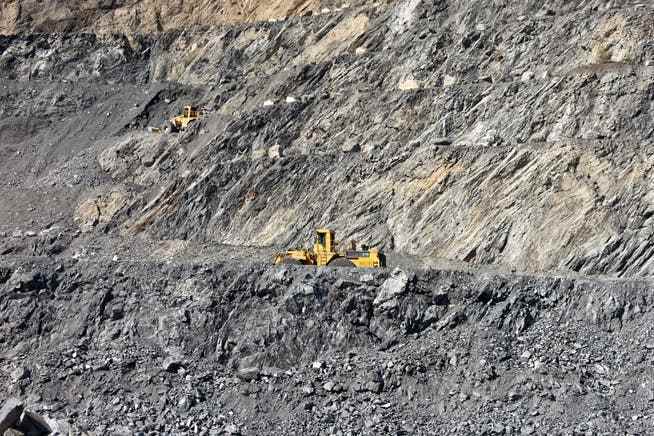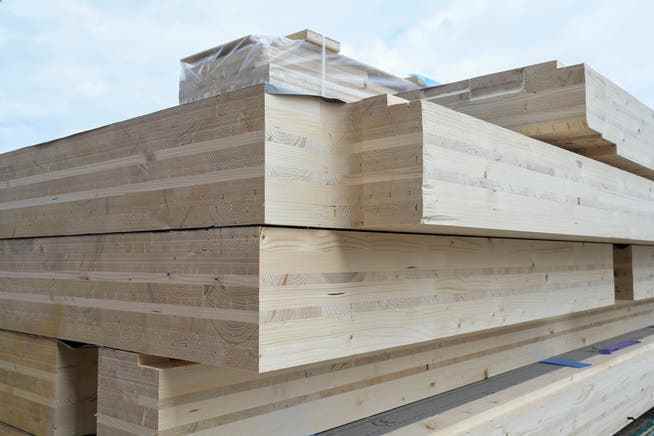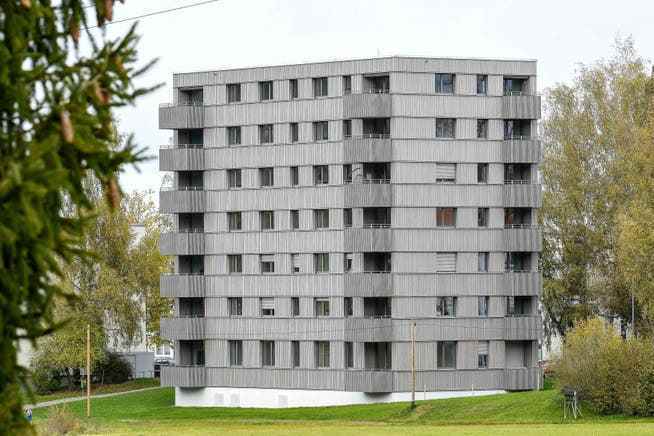Concrete is notorious as a climate sinner. Wood is now celebrating a revival. Politicians, forest owners, scientists and environmental activists – many of you have been promoting the use of wood instead of steel and concrete in the name of climate protection for some time.
In Hamburg, Germany’s tallest wooden skyscraper is being assembled in HafenCity using prefabricated wooden segments made of larch.

You are reading an excerpt from the “Planet A” newsletter by Kalina Oroschakoff. “Planet A” is about climate change and its effects on our life, our work, our future. Click here to subscribe to the German edition of «Planet A»and here to get the Swiss version.
«You can love or hate concrete, if you use it correctly, you will experience it as marble of the 20th century.»
That wrote the German architect Jan Störmer in 2012. Ten years later he is building Germany’s tallest wooden skyscraper, it is one of his last projects. The now 80-year-old has found his way back to the oldest building material in the world. Building with wood is more fun for him today, he says.
Today, concrete is notorious as a climate sinner. A lot of CO is produced during its production2. Politicians, forest owners, scientists and environmental activists – many of them advertise for some time for using wood instead of steel and concrete in the name of climate protection.
Jan Störmer also says that wood is “fantastic” as a material. The insulation alone is awesome. The building sector is for over 35 percent of greenhouse gas emissions in the EU, climate-friendly solutions must also be found here. This is becoming all the more urgent as more and more people are moving to cities around the world. It needs new housing. Lumber causes less CO in its production2. Wood binds and stores CO2 and thus removes it from the atmosphere – at least for a certain period of time.
Wooden houses aim high
Just last week, the Potsdam Institute for Climate Impact Research wrote in a message that by the end of the century emissions of more than 100 billion tons of CO2 could be saved if the majority of the growing world population lived in high-rise buildings made of wood. Translated into the language of the Paris climate agreement, this would correspond to about 10 percent of what we still have in CO2 can emit to meet the 2 degree target.
But here, too, there are conflicting goals. In addition to natural forests, large quantities of newly created timber plantations would also be required to supply timber of this size. Although this does not affect food production, the researchers say it could lead to a loss of biodiversity.
The study, their assumptions too have their critics shows that in addition to all the hype surrounding the use of wood, unwanted and negative effects are increasingly coming to the fore. On request, the German Environmental Aid warns against overconsumption of wood and also points out the deteriorating condition of the forests after years of drought and pest infestation. Wood production must be demonstrably sustainable.
It takes strong political governance and careful planning to ensure that wooden houses play an important role in mitigating climate change, say the researchers at the Potsdam Institute.
It certainly needs political support. Architect Jan Störmer experienced this himself. Germany lags behind when it comes to building with wood, he says in an interview. In other countries, high-rise buildings over 100 meters are already being planned. This includes also Switzerland. Hamburg’s wooden high-rise will be 65 meters high. The so-called «Roots» project is to house apartments, offices and exhibition space on 19 floors in Hafen-City, writes the Hamburg Senate.

The cement and concrete industry comes because of their CO2-Footprint under pressure.
Building higher in Hamburg
That the tallest wooden building in Germany will be there was not actually planned, says Störmer. It all started with that being architecture office took part in a competition for a wooden house – not a high-rise – and didn’t win first prize. But the project of the Hanseatic City of Hamburg, which sat on the jury, caught the eye. And so it happened that since 2018 a wooden high-rise has been planned and built on a property in Hafen-City.
Störmer’s goal: “Let’s try to catch up with international developments in Sweden, Austria and Canada,” he recalled in conversation. Obstacles quickly arose in the form of German legality: “Our building regulations are simply more complicated and bureaucratic,” he says. Something urgently needs to change.
In this case, however, the bureaucracy cooperated and developed exception rules that could possibly be introduced into the building code, says Störmer. A high-rise building with a combustible structure is not permitted under building regulations, explains a presentation he put together about the project. Fire protection is not the biggest problem, he says in an interview, but the concerns persisted.
Hamburg is also interested in to score with this project. The Senate has been supporting building with wood since 2017, partly because the high degree of prefabrication means that the construction time can be significantly reduced. Meanwhile, Störmer’s office had four years to plan and prepare. Actually much too long for an architect’s office, he says himself. The project was more of a research work, one that paved the way for more wooden buildings and the corresponding adjustments to the building regulations. In the meantime, things are moving in Germany. Baden-Wuerttemberg about have adjusted its building regulations, also Berlin. “It’s progressing rapidly,” says Störmer.

The tallest wooden skyscraper in Germany is being built in HafenCity in Hamburg. The picture shows an assembly of prefabricated wooden ceiling segments.
Light wood for building
If you visit the construction site today, you don’t even have to make an effort to imagine the finished building. The wooden skeleton can be seen through the scaffolding. Floor slabs made of wood are stacked on top of each other on the construction site.
No cut, thick wood is used here, as is known from half-timbered houses. Instead, high-quality glulam binders are used, says Störmer. This is a completely different way of making wood statically resilient without stretching or shrinking.
Laminated trusses are therefore ideally suited to making large structures out of them. “You can cut them with millimeter precision like concrete. That’s the important thing,” says Störmer. The difference is that wooden panels can be recycled. Concrete slabs could be smashed, but actually not reused (even if that is in Switzerland already doable is).
As an architect, Störmer actually has nothing more to do. On the construction site, it’s now just a matter of assembly, he says. In principle, the house is a screwed-together, orderly material warehouse in which people can live. According to German building law, lift shafts or stairs may only be built in concrete. The walls, however, were broken down into individual wooden construction elements that are prefabricated. “Everything is industrially manufactured, that’s the big difference to conventional construction.”
According to Störmer, the future will increasingly involve prefabrication. Around the CO2-To reduce the footprint of the construction sector, but also because there are no longer enough skilled workers for busy construction sites. «Timber construction is like car construction – it has to be planned in advance. We architects don’t really have anything to do with the construction site because everything is ready.” The construction in Hamburg would produce 31 percent CO compared to conventional construction2 save, says the project presentation.
Today, such a wooden house project is even more expensive, but not for much longer, Störmer is convinced. With the rapid prefabrication would also come the cost savings, especially if you go in bulk. At the same time, it is important not to waste the wood. The motto must be: “So little, but so meaningful.”
It starts with the forest
That brings us to the forest, the place where the wood comes from. Störmer asks himself many questions: What does it take to make timber construction fit for the future? Which trees does it have to be? Which species are resistant and can withstand droughts? Which trees grow so fast that they really make it into the economic cycle?
Störmer talks about this regularly with forest owners and foresters. Among others with Fried Bernstorff. The nobleman from Lower Saxony owns one of the largest forest estates in northern Germany. When asked, he says that building with wood is an absolute topic of the future. Climate change and the associated drought are a problem for forestry. The corresponding conversion of the forests is already taking place, forests would become more diverse.
Which tree species will be needed in the future? The question is very important, if difficult, says Bernstorff. One has to do with this in Germany with tight thinking corsets. Many environmentalists insist on native tree species. she warn against to encourage fast-growing conifers. According to Bernstorff, the aim is to find trees that can cope with much less water. An example is the Douglas fir. It is originally at home in North America. Or the silver fir. Pine also copes better with less water than spruce.
“The most important thing is to have a healthy mix,” says Bernstorff. Mixed forests are also better suited to meet the increasing demand. Trees grow faster in such forests.

The first wooden skyscraper in the Allgäu was built with spruce wood, while the facade consists of pre-greyed larch boarding. Larch is also used in Hamburg for the facade.
It depends on the mixed forest and the price
While many activists for years Störmer is a fan of the Douglas fir. It is actually an ideal tree, even if it is still too expensive because there are not enough of them in Germany. But actually cheap wood was needed for the glued board layers, he says.
The beech is too heavy for it, as is the oak. Pine, fir, larch – all light woods, on the other hand, are ideal for gluing. “Of course, the market asks where I can buy the cheapest wooden board,” says Störmer. Valuable wood can be used to make beautiful planks, floors and stairs, but they are not for general building with wood. “The forest has to adapt to that.”
Störmer will soon only be watching this development from the sidelines. He wants to retire from the day-to-day work of an architect. In the meantime, his office is increasingly using wood. Around 25 years after he built his first wooden house, around 40 percent of construction projects, hotels and office buildings are now worked on with wood, he says.
So will everything soon be made of wood?
Störmer says no. The future never just follows one path. The steel construction will not stop. He cannot be topped when it comes to bridge building. The age of concrete is not over either. There is hardly a foundation where concrete is not needed. “One should only minimize the concrete.”
